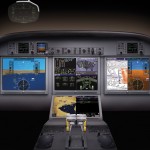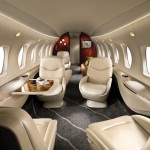
Cessna’s new Citation Columbus is configured to seat up to 10 passengers. Featuring a flat floor that offers more than 73” of standing aisle height and its recessed, direct and task lighting is in cool, controllable LED.
By Karen Di Piazza
Although several states wooed the Cessna Aircraft Company with incentives to build its new $27 million Citation Columbus jet, Kansas lawmakers did what they had to do to keep the plane maker’s project in Wichita.
To keep the economy rolling, on April 2, the Kansas Senate passed a measure, voting 36-2, to provide up to $150 million for businesses involved in aviation development, research, engineering and manufacturing. Late Friday evening, on April 4, the Kansas House passed the bill, dubbed “the Cessna bill.” Some lawmakers weren’t happy about having to take a vote late at night.
Cessna, as well as other aviation-related companies, will have access to $33 million in bonds as part of the bill to secure its stand-alone facility. Kansas hopes to lure other manufacturers with its new incentives. Bombardier is on the state’s list; however, the company has publicly said it’s happy in Canada.

The private enclosed lavatory depicted on this Citation Columbus is an example of opulence at its best.
On April 5, city, county and state lawmakers attended Cessna’s news conference, where Jack Pelton, company chairman, president and CEO, officially announced that its new Columbus plant would be built in Wichita. The news was significant for the state’s aviation stakeholders. Cessna is investing $780 million into its new jet project—the largest plane in the company’s 81-year history.
Pelton credited the legislature’s quick response to the Columbus project for cementing the company’s decision. He said state leadership “showed the world that Kansas will compete for aviation jobs.” In addition to the state’s incentive package, the company valued Kansas’ world-class work force. In particular, Pelton praised the new technical training facility at Colonel James Jabara Airport (AAO) and the National Institute for Aviation Research.
“We needed to make this decision quickly,” Pelton said. “The Kansas Legislature was very proactive in its response. This is a perfect example of our partners at the state level understanding and responding quickly to a very competitive global business environment.”

The Columbus’ interior space is plentiful for a custom-designed galley, fit for any gourmet-seeking cook or flight attendant.
That may be, but Cessna’s parent company, Textron Inc., put the word out, with its financial and lobbying clout, that if Kansas wanted its Columbus business, lawmakers needed to make it happen before the House wrapped up session.
The new facility, slated to break ground by the end of the year, will house engineering offices and final assembly. The Columbus jet is expected to have a 4,000-nacutial-mile range nonstop at Mach .80. Preliminary performance numbers set a maximum cruise speed of 488 knots and a maximum operating speed of Mach .86. Configured to seat up to 10 passengers, the cabin’s interior is spacious; its length is 36.3 feet, including interior baggage space. The twin-engine jet will debut Pratt & Whitney Canada’s PW810 engine, touted as an environmentally friendly engine that will make the most of fuel efficiency. Cessna plans to achieve Federal Aviation Administration certification by the end of 2013, with deliveries beginning in 2014.
Pelton said the Columbus project would create 1,010 new jobs, with an annual payroll of $74 million. In persuading lawmakers to pass the bill quickly, Cessna did some research that showed each job will create an additional 2.9 jobs, which will overall create 4,000 new jobs in the state.

The twin-engine, $27 million Columbus will be the largest plane produced in Cessna’s 81-year history and will debut Pratt & Whitney Canada’s PW810 engine. The jet is scheduled for FAA certification by the end of 2013, with deliveries beginning in 2014.
A study by the Center for Economic Development and Business Research at Wichita State University reported that for each $1 the state invested, $2.14 would result in returned revenue.
“From the beginning, Cessna was clear that they wanted to build this (jet) in Kansas,” said Melvin Neufeld, Kansas House speaker. “We knew we had tough competition from other states, but we also had the home court advantage. Our message is clear: we want these companies and these jobs in Kansas.”
Wichita is responsible for 40 percent of the world’s general aviation aircraft. Through employee taxes, nearly 22 percent of the state’s $5.9 billion general fund is supported by the industry.
For more information, visit [http://www.cessna.com].
- The aircraft’s 15-inch displays offer the most advanced all-glass technology in the company’s history. The point-and-click access allows for flight planning, aircraft performance monitoring, hazard avoidance and much more.
- The luxurious cabin length is 36.3 feet, including interior baggage space. Reclining leather seats make for perfect naps, but when you’re not sleeping, seats turn, swivel, pivot and slide, allowing ultimate comfort for work or for play.













